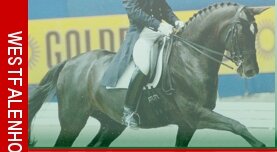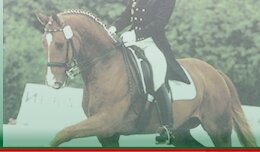


 |
 |
 |
|||
|
Westfälisches
|
Scope Building: Cavaletti, Gymnastics, and Progressive OxersWhen you’re looking to build your horse’s scope, it’s not just about jumping higher fences. Cavaletti, gymnastic lines, and progressive oxers each bring unique benefits that help your horse gain balance, rhythm, and strength. By thoughtfully combining these elements in your training, you’ll set a solid foundation for long-term success. The right approach can make all the difference—let’s explore how these tools can elevate your program and challenge your horse’s athletic potential. Understanding Cavaletti and Its PurposeCavaletti serves as a practical tool in equestrian training, consisting of low poles that can be adjusted in height to enhance the movement of horses. Incorporating Cavaletti exercises into training routines can contribute to the development of a horse's strength, flexibility, and overall engagement. Commonly performed at the walk or trot, these exercises promote the lifting of the horse's legs, which can lead to improvements in cadence and body control. To ensure the safety and effectiveness of the exercises, appropriate spacing is crucial. For ground poles, a distance of 2.5 to 3 feet is recommended, while trot poles should be spaced approximately 4 feet apart. The use of Cavaletti isn't limited to the training of basic gaits; it can also introduce variation in training sessions, which may help maintain the horse's focus and reinforce correct movement patterns. Research indicates that Cavaletti exercises can be beneficial in improving specific physical attributes, such as coordination and rhythm. Key Benefits of Cavaletti Work for Jumping DevelopmentCavaletti work is a useful component of equestrian training that enhances a horse's jumping development by focusing on essential elements such as rhythm, balance, strength, and flexibility. These exercises are designed to improve a horse's rhythm and balance, which are critical for maintaining control and precision when approaching and clearing obstacles. One of the key benefits of incorporating cavaletti work is the improvement in a horse’s strength and flexibility, particularly in the hindquarters. This increased strength is important for generating the power needed for effective jumping. Additionally, using elevated cavaletti can create a training environment that simulates actual jumping conditions, thereby facilitating core engagement in both the horse and rider. Moreover, cavaletti exercises contribute to the horse's proprioception, which enhances the horse’s awareness of its body positioning. This heightened awareness often results in smoother and more elastic strides, which can lead to improved jumping performance. These benefits are applicable to horses at various levels of experience, from novice to advanced, making cavaletti work a versatile training tool in the development of jumping skills. Essential Equipment and Setting Up Safe ExercisesTo effectively incorporate cavaletti work into your horse's jumping routine, it's essential to utilize appropriate equipment and maintain a secure environment. Select robust cavaletti poles that are typically 8-10 feet in length, positioned on cross stands with adjustable heights ranging from 10 to 15 inches. It's important to conduct a thorough inspection of your equipment prior to each training session, ensuring there are no splinters or signs of wear that could compromise safety. Commence the training with ground poles situated on level, even surfaces to allow your horse to acclimate to the stride and rhythm required. Once the horse demonstrates proficiency with these, you may advance to raised cavaletti. Implement varied spacing of ground poles during exercises to provide rest intervals, which can prevent fatigue and minimize the risk of overwhelming the horse. This structured approach helps to promote a safe and effective training regimen. Recommended Distances and Heights for Effective TrainingTo effectively set up your horse for success with cavaletti work, it's essential to adhere to recommended distances for various types of poles. For ground poles, a spacing of 2.5 to 3 feet is advisable, while trot poles should be positioned approximately 4 feet apart. Canter poles, on the other hand, are best placed between 9 and 11 feet, with these distances adjusted based on the individual horse’s stride. In terms of height, for beginners, cavaletti should be maintained at 6 to 8 inches high, and when practicing cantering, the height should never exceed 20 inches. Ensuring the horse's comfort and safety is paramount; thus, regular inspection of the poles is necessary, and training should take place on a flat, even surface. It is also beneficial to start with straightforward exercises, progressing gradually to more complex patterns as the horse becomes more comfortable and skilled. Following these guidelines can lead to effective and safe learning experiences in cavaletti training. Gymnastics: Enhancing Balance, Coordination, and AgilityIntegrating gymnastics into your horse's training routine can enhance various physical abilities, specifically balance, coordination, and agility. By incorporating cavaletti exercises, you can target muscle development through the use of varied pole work. Properly assessing and adjusting the distances and heights of cavaletti is essential for maximizing the effectiveness of this training approach. Transition points across pole sequences can be tailored to improve your horse's proprioception, helping them navigate different gaits with greater precision. Regular engagement with ground poles in a controlled manner encourages refinement in stride length and rhythm, which can enhance the horse's ability to adapt its approach during take-off and landing. Moreover, consistent practice with gymnastics fosters improved responsiveness in horses, equipping them to manage tight turns effectively. This methodical training promotes carefulness, which is a critical attribute for performance when confronting obstacles. Designing Progressive Oxers for Scope ImprovementWhen designing progressive oxers for the purpose of scope improvement in horses, it's essential to provide the appropriate foundation for jumping competency. Starting with cavaletti can help establish a solid rhythm and balance, which are critical for an effective jump. As the horse becomes more comfortable with these preliminary exercises, the transition to oxers can be made. Progressive oxers should be approached by gradually increasing both height and width. This incremental adjustment allows the horse to improve jumping technique and strength while minimizing the risk of injury or stress. It's necessary to tailor the setup based on the individual horse’s characteristics, such as its experience level, physical condition, and jumping style. To facilitate scope development, the base of the oxer can be widened while the height is varied methodically, thus allowing the horse to experience different challenges without becoming overwhelmed. This strategy is grounded in the principles of progressive training, ensuring that scope improvement occurs steadily and safely. Step-By-Step Progression From Simple to Complex ExercisesEstablishing a strong foundation in horse training involves a systematic approach to exercises, progressing from simple to complex tasks. Initially, incorporating one or two ground poles, appropriately spaced for the horse's stride, serves as an effective introduction to basic cavaletti exercises. This approach helps the horse develop rhythm and understanding of the task. Following the ground poles, the next step may involve the use of trot poles set approximately four feet apart. This exercise encourages the horse to focus on maintaining rhythm and engagement while navigating the poles. Subsequently, the introduction of canter poles or spaced cavaletti is advisable. These exercises require the horse to demonstrate balance and execute proper transitions between gaits. To further enhance accuracy and lead changes, exercises such as figure eights incorporating cavaletti can be beneficial. This complex exercise demands concentration and coordination from the horse as it navigates the course. Finally, as proficiency increases, raising cavaletti or constructing small gymnastic exercises can be integrated. This step-by-step progression ensures that the horse builds confidence and skill in a structured manner, addressing challenges incrementally. Sample Cavaletti and Gymnastic Exercises for Every RiderCavaletti and gymnastic exercises are fairly well-recognized techniques for enhancing equine performance across various skill levels. Initiating practice with ground poles and straightforward cavaletti exercises arranged in a straight line allows the horse to develop rhythm and introduces them to gymnastics effectively while walking, trotting, and cantering. As competency increases, elevated cavaletti and fan-shaped arrangements can be introduced to promote enhanced coordination and balance in the horse. Implementing figure-eight patterns with two cavaletti positioned at right angles encourages horses to make precise turns and lead changes, which are critical for their overall agility. Moreover, incorporating transitions between gaits within these exercises can significantly contribute to building strength and flexibility in the horse. As the horse becomes more adept, the introduction of progressive oxers can serve to further their athletic development and challenge their capabilities. This structured approach to training can lead to improved performance in various equestrian disciplines. Tips for Monitoring Success and Adjusting Your ProgramMonitoring the effectiveness of a cavaletti and gymnastics program is essential for ensuring the ongoing development of your horse. It's important to regularly assess the horse's performance during exercises and monitor their stride length. This information can help determine whether adjustments to the spacing of the cavaletti are necessary to support optimal performance. The frequency of training sessions should be aligned with the horse’s current physical condition and engagement. A balanced approach can promote muscle development while minimizing the risk of fatigue. Keeping a detailed log of each session enables the identification of performance trends and helps evaluate the need for program adjustments. Feedback from an experienced trainer can be invaluable in refining exercise techniques and introducing variation to the training routine. This can enhance the challenge of the program while maintaining a focus on safety and effectiveness. Regular and well-considered adjustments to the training regimen contribute to the horse's progressive improvement. ConclusionBy incorporating cavaletti, gymnastics, and progressive oxers into your routine, you’ll build your horse’s scope, strength, and confidence over fences. Stay attentive to your horse’s needs, adjust exercises as you go, and celebrate every bit of progress. With patience and consistency, you’re setting both yourself and your horse up for success in any jumping discipline. Keep challenging yourselves, and you’ll see just how much your partnership can achieve in the saddle. |